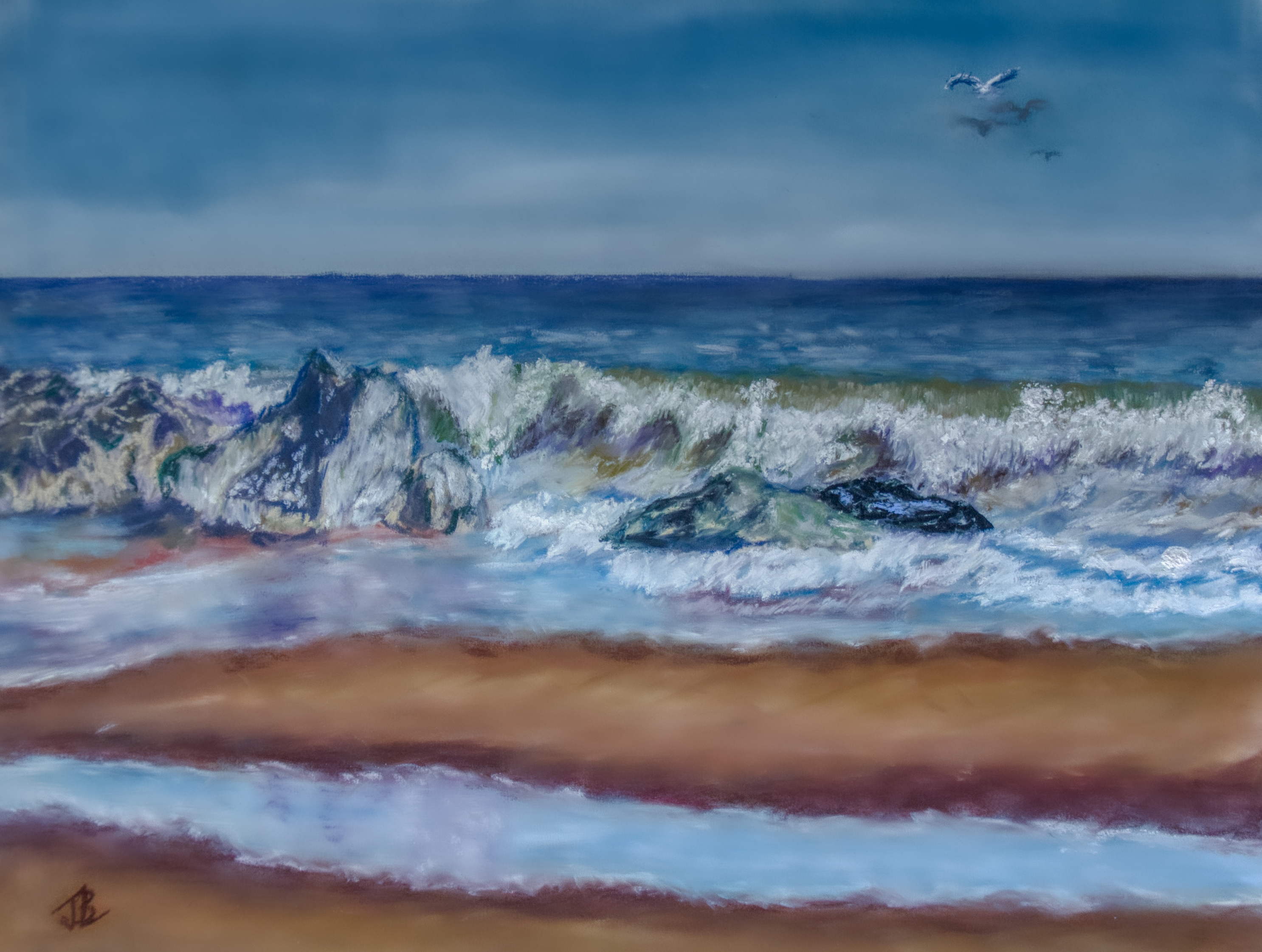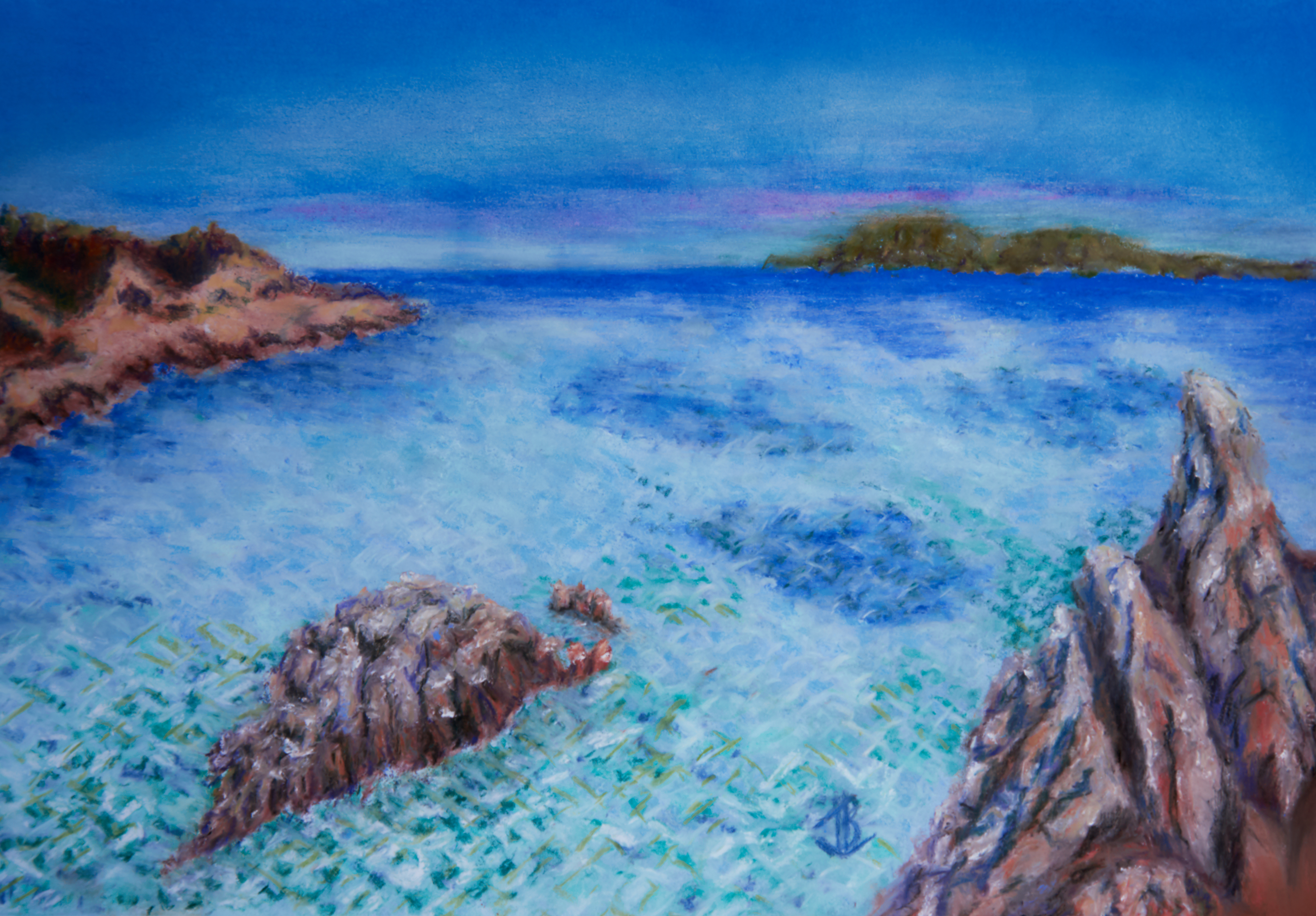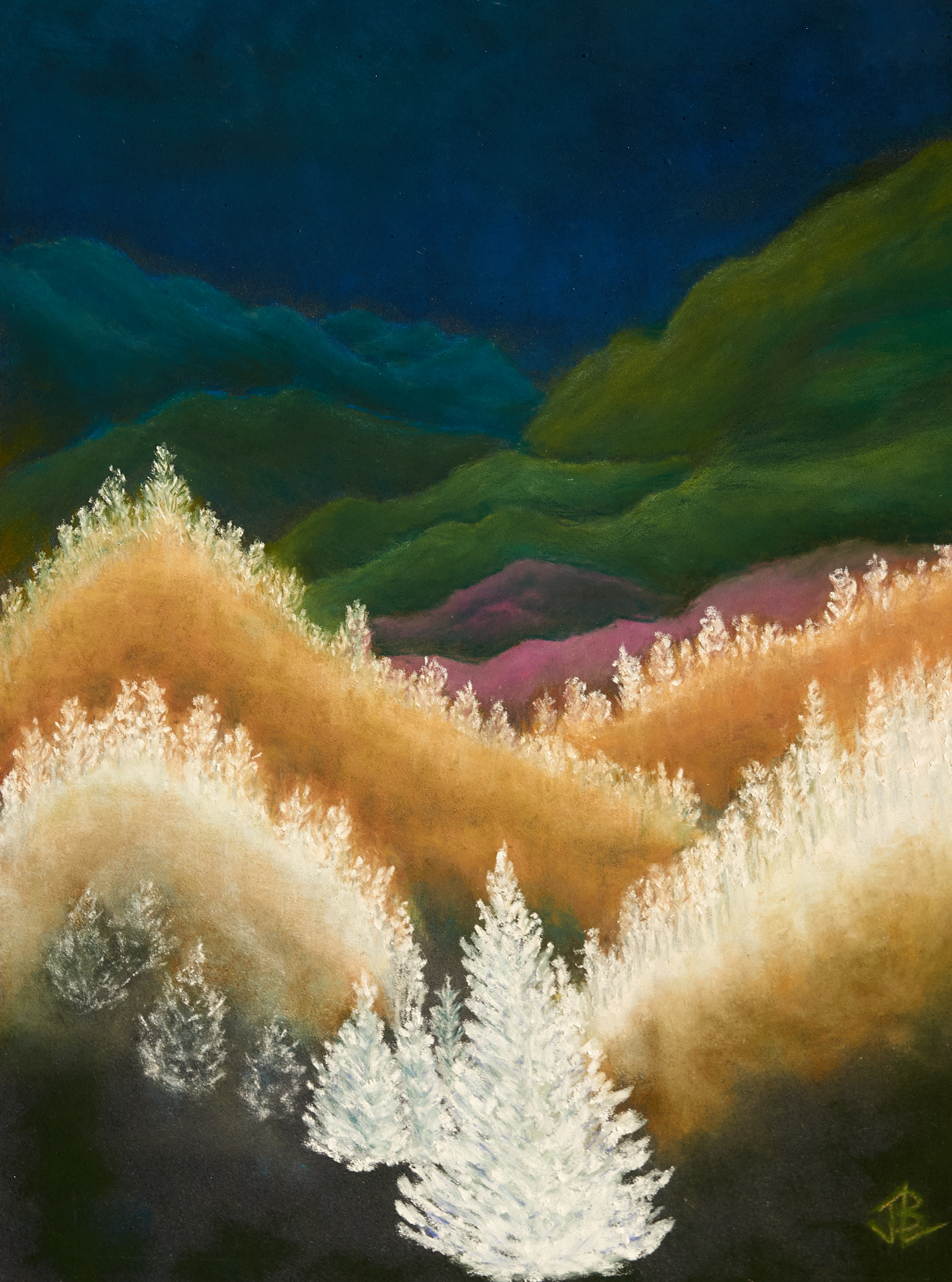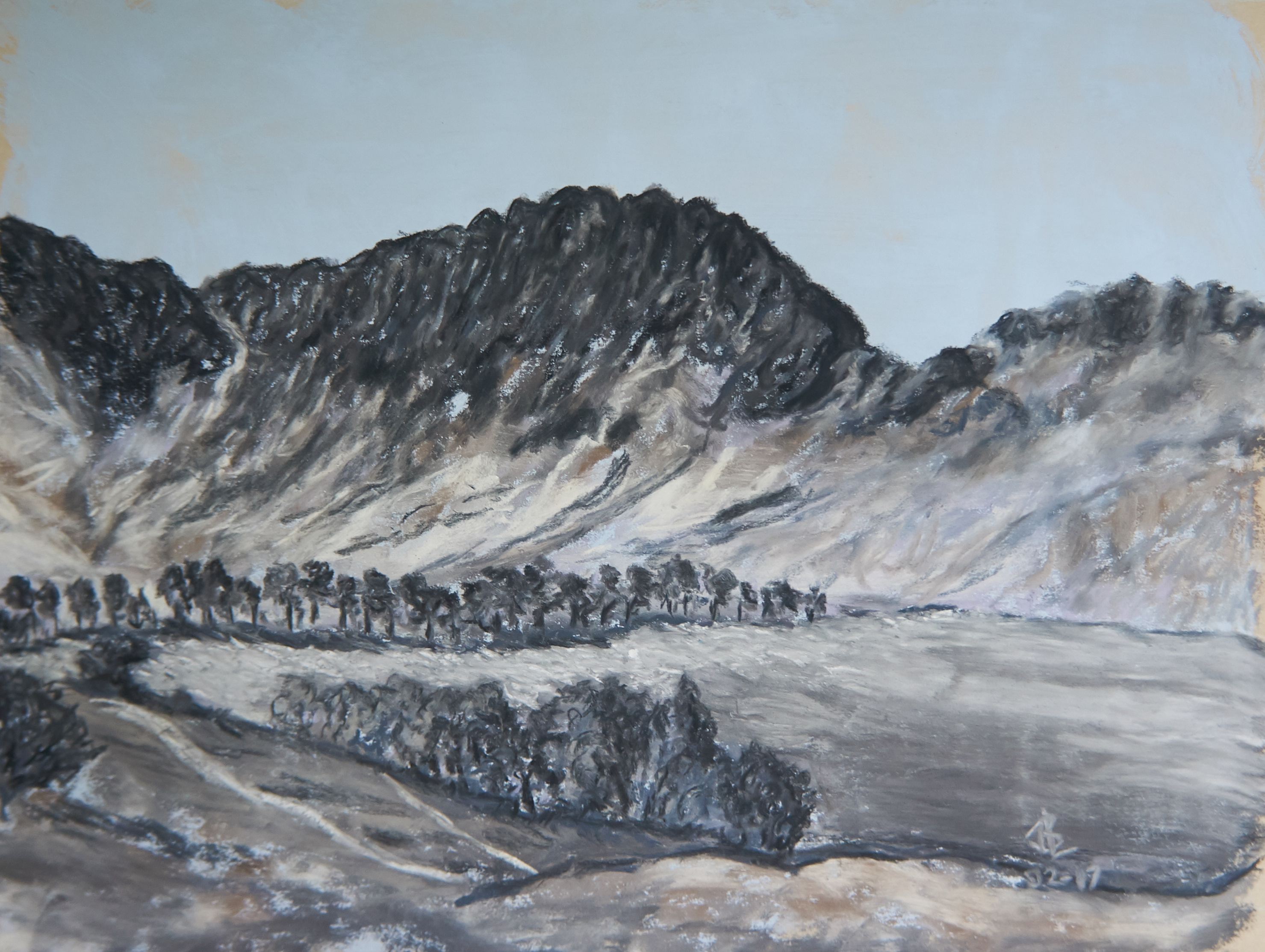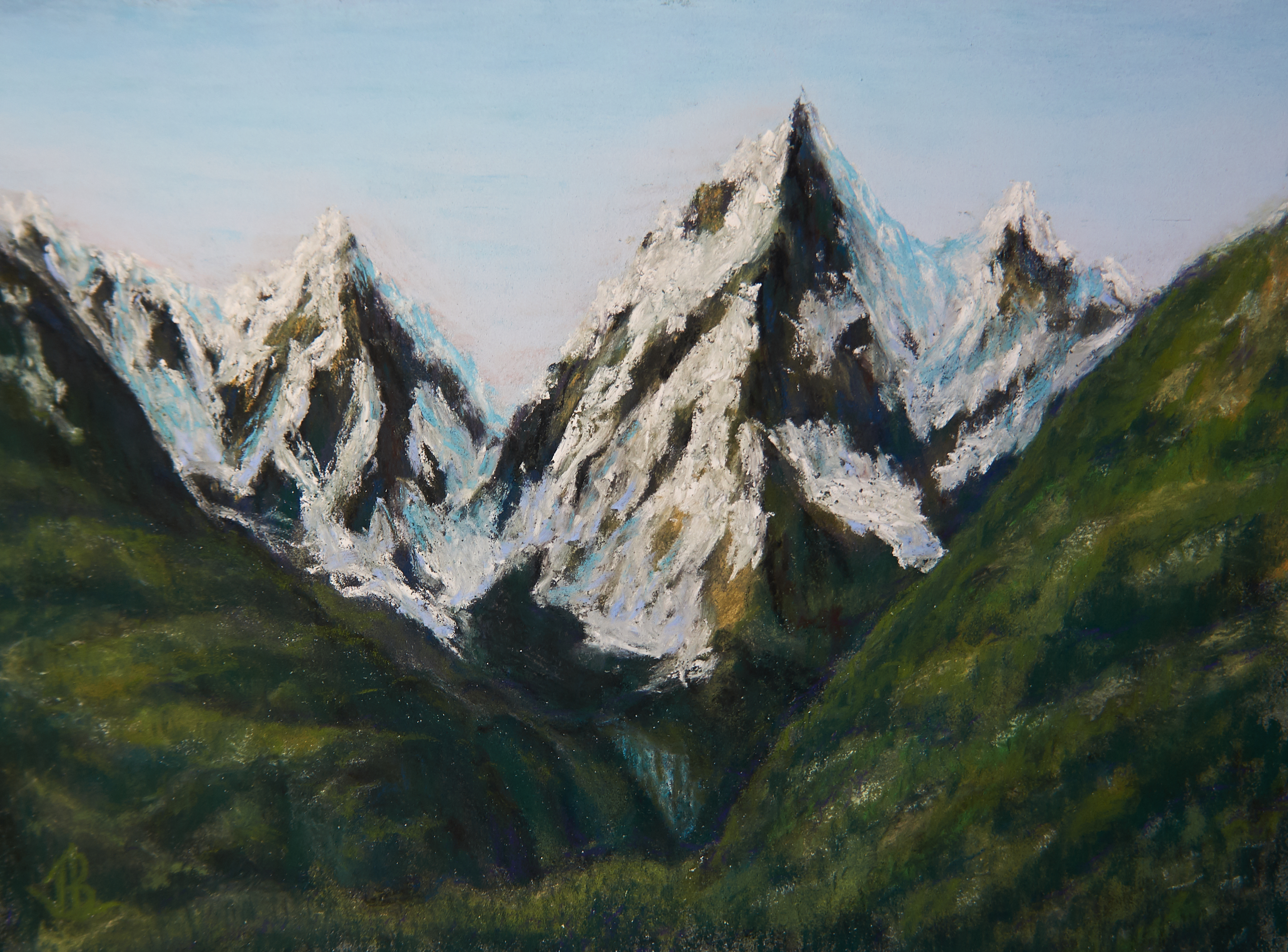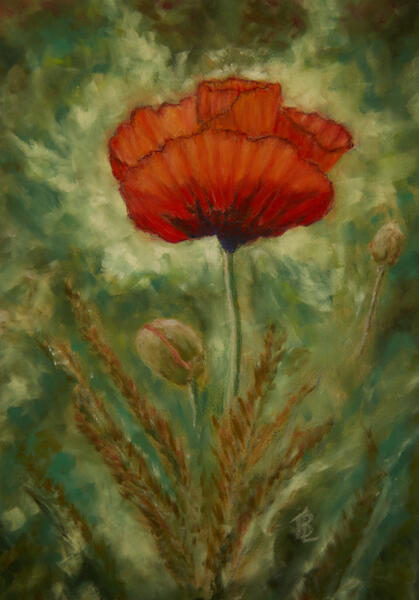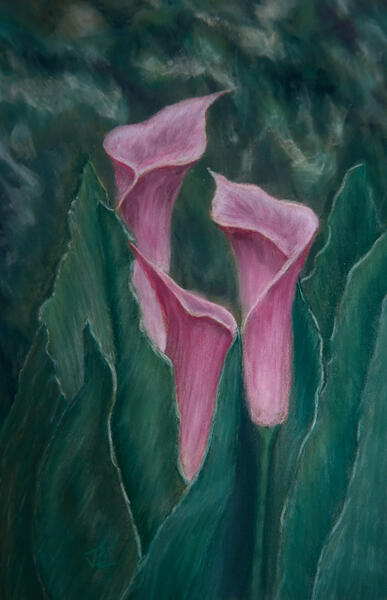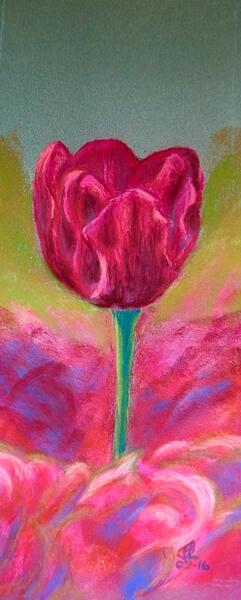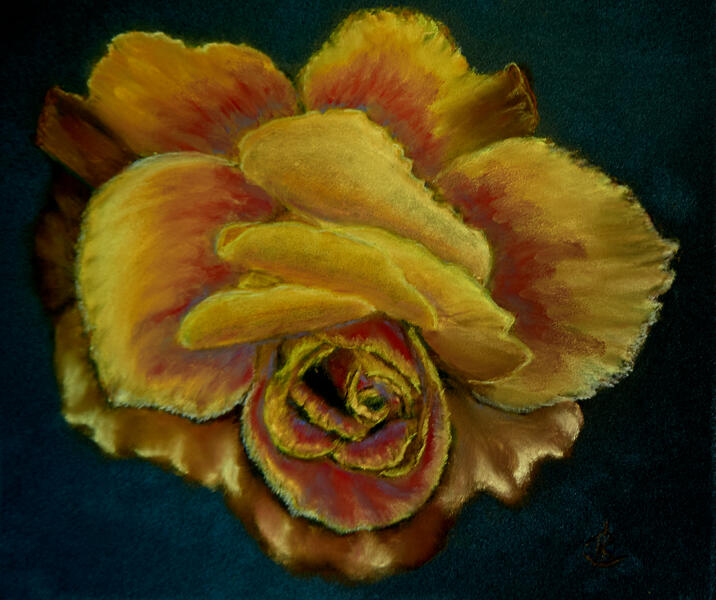Work samples
-
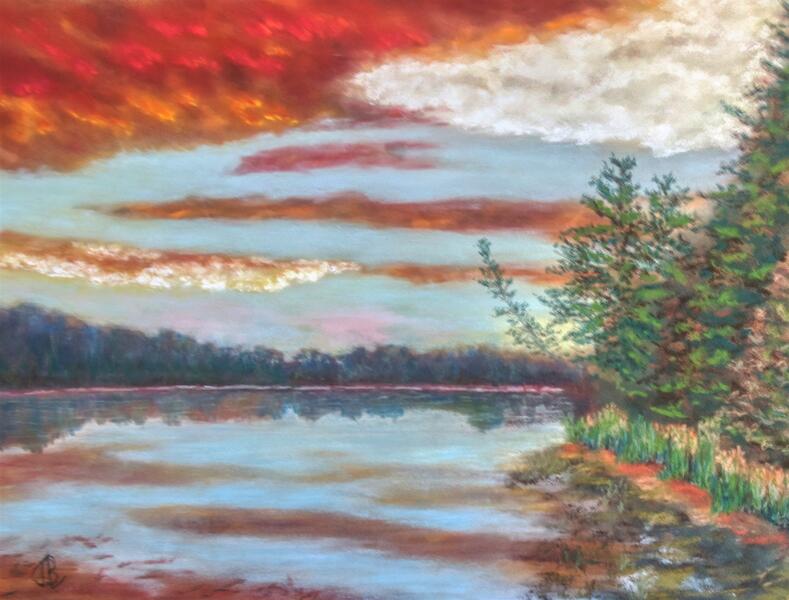 Red Rust SunsetThe setting sun created a blanket of vibrant rusts and reds, late on a July evening. The headwaters of the Mississippi river are unseen here, hidden by the dense ponderosa pines. [Clouds, sky and water painted in PanPastels high-pigment paints. Ponderosas and special effects for water and sky added with hand-made Mungyo soft pastel sticks and Bruynzeel pastel pencils. Painted on acid-free Sennelier 200 lb sanded paper.]
Red Rust SunsetThe setting sun created a blanket of vibrant rusts and reds, late on a July evening. The headwaters of the Mississippi river are unseen here, hidden by the dense ponderosa pines. [Clouds, sky and water painted in PanPastels high-pigment paints. Ponderosas and special effects for water and sky added with hand-made Mungyo soft pastel sticks and Bruynzeel pastel pencils. Painted on acid-free Sennelier 200 lb sanded paper.] -
 Two-Horse Open SleighWe get only a glimpse of the open sleigh behind our horses. With two Belgian draft horses, the sleigh will speed along. The fine snow continues to fall, obscuring the woods in the background. The horses' tackle shines with damp, highlighted by the light so vividly reflected by the snow. [Underpainted with PanPastels, set with an alcohol wash. Over-painted with hand-made soft pastel sticks and Bruynzeel pastel pencils. Painted on acid-free UART 600-grain sanded paper.]
Two-Horse Open SleighWe get only a glimpse of the open sleigh behind our horses. With two Belgian draft horses, the sleigh will speed along. The fine snow continues to fall, obscuring the woods in the background. The horses' tackle shines with damp, highlighted by the light so vividly reflected by the snow. [Underpainted with PanPastels, set with an alcohol wash. Over-painted with hand-made soft pastel sticks and Bruynzeel pastel pencils. Painted on acid-free UART 600-grain sanded paper.] -
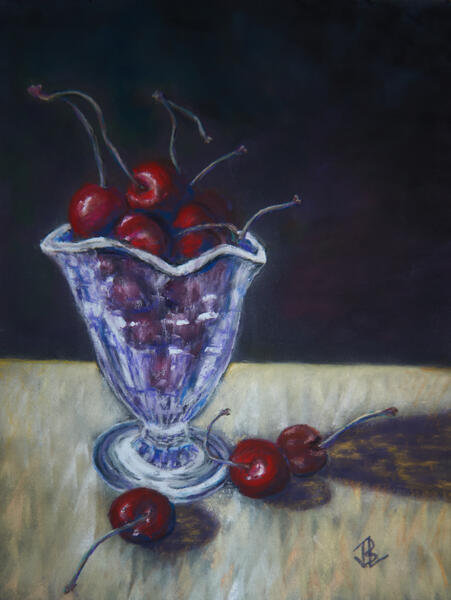 Glass of CherriesThe deep red cherries are perfect for eating. Some already fall off their stems. A nearby window and sharp sunlight makes every angle glint in the tulip-shaped glass bowl, casting vivid shadows across the table. [Background and table painted in PanPastels, high-pigment powdered paints. Overpainted with traditional hand-rolled soft pastel sticks and soft pastel pencils from the Netherlands.Painted on black acid-free Sennelier 200lb La Carte sanded paper.]
Glass of CherriesThe deep red cherries are perfect for eating. Some already fall off their stems. A nearby window and sharp sunlight makes every angle glint in the tulip-shaped glass bowl, casting vivid shadows across the table. [Background and table painted in PanPastels, high-pigment powdered paints. Overpainted with traditional hand-rolled soft pastel sticks and soft pastel pencils from the Netherlands.Painted on black acid-free Sennelier 200lb La Carte sanded paper.] -
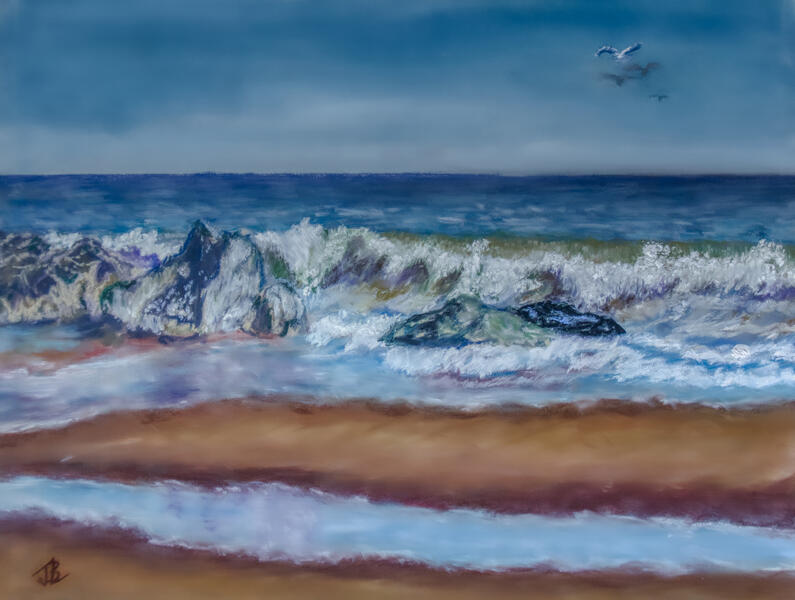 Green TideIt’s always summer at the southern beach of Cape Henlopen State Park. North of Rehoboth Beach, this quiet November scene is in the Gordon Pond Wildlife Area, beside its pavilion. The colorful tide pools provide a cheerful foreground for green-shadowed rolling breakers. [Painted with PanPastels, Sennelier soft pastels and Bruynzeel pastel pencils. Painted on acid-free UART 800 grain sandpaper.]
Green TideIt’s always summer at the southern beach of Cape Henlopen State Park. North of Rehoboth Beach, this quiet November scene is in the Gordon Pond Wildlife Area, beside its pavilion. The colorful tide pools provide a cheerful foreground for green-shadowed rolling breakers. [Painted with PanPastels, Sennelier soft pastels and Bruynzeel pastel pencils. Painted on acid-free UART 800 grain sandpaper.]
About Barrie
Barrie Leigh was born and raised in Cumberland at the heart of the English Lake District. Views of mountains like Great Gable, Scafell, Seatallan, Helvellyn, and their nearby rivers and lakes, created his love of landscapes and nature. The colors and patterns of the mountain scenery changing their moods as seasons go by.
Barrie lived only a couple of miles from the tallest mountain, by the deepest lake, with the smallest school, and the smallest church in England. The colorful flower… more
Barrie lived only a couple of miles from the tallest mountain, by the deepest lake, with the smallest school, and the smallest church in England. The colorful flower… more
Jump to a project:
The Artists’ Tale―The Story
It was only last year, around this time, that the presentation of the Baker Artist Portfolios caused a stir in my local library. Rows of aspiring creative-arts people half-filled the room: the library staff were anxious to close the doors and go home for the day. Wrapping up the session, the presenter held us all with his steady gaze, a twinkle in his eye, and exclaimed:
“Let me tell you the very best advice I can give you about presenting your portfolios!… ” You could have heard a pin drop.
“Tell your story; describe your journey; explain your mission, but invite the visitors and judges to join you in your travels.
Encourage them to come with you on your trip. Show how you've been investigating and exploring your medium deeply―but do it in a way they will understand and enjoy…”
Some, stared blankly ahead. Others frowned. I held my head in my hands, as a mental gasp rippled among the crowd:
“You mean, we're on a journey?”
“Oh yes. So in your projects show the direction and depth of your artistic explorations.”
And so we began…
“Let me tell you the very best advice I can give you about presenting your portfolios!… ” You could have heard a pin drop.
“Tell your story; describe your journey; explain your mission, but invite the visitors and judges to join you in your travels.
Encourage them to come with you on your trip. Show how you've been investigating and exploring your medium deeply―but do it in a way they will understand and enjoy…”
Some, stared blankly ahead. Others frowned. I held my head in my hands, as a mental gasp rippled among the crowd:
“You mean, we're on a journey?”
“Oh yes. So in your projects show the direction and depth of your artistic explorations.”
And so we began…
Shifting Seas―Emotion With Movement
The fascination for the ocean comes from its ever-changing moods. From danger to delight. From lapping to luscious. The challenge for an artist is well beyond the normal "motion" that's needed in a painting. In this watery world there are many emotions of the ever-moving seas. The seascapes, like other paintings, need motion with a purpose. A distinctive feeling that underlies the scene. Do the waves crash into each other? Does the glowering storm move to the sailboat faster than its homeward course? Do the rocks around the bay carry you , clambering, on a sunny outing around the crystal bay?
-
 Green Tide23½ x 19½ inches, framed Ambling towards the Delaware coast, the atlantic swell comes in like a roller on a golf course. It’s always summer at the southern beach of Cape Henlopen State Park. North of Rehoboth Beach, this quiet November scene is in the Gordon Pond Wildlife Area, beside its pavilion. The colorful tide pools provide a cheerful foreground for green-shadowed rolling breakers. [Painted with PanPastels, Sennelier soft pastels and Bruynzeel pastel pencils. Painted on acid-free UART 800 grain sandpaper.]
Green Tide23½ x 19½ inches, framed Ambling towards the Delaware coast, the atlantic swell comes in like a roller on a golf course. It’s always summer at the southern beach of Cape Henlopen State Park. North of Rehoboth Beach, this quiet November scene is in the Gordon Pond Wildlife Area, beside its pavilion. The colorful tide pools provide a cheerful foreground for green-shadowed rolling breakers. [Painted with PanPastels, Sennelier soft pastels and Bruynzeel pastel pencils. Painted on acid-free UART 800 grain sandpaper.] -
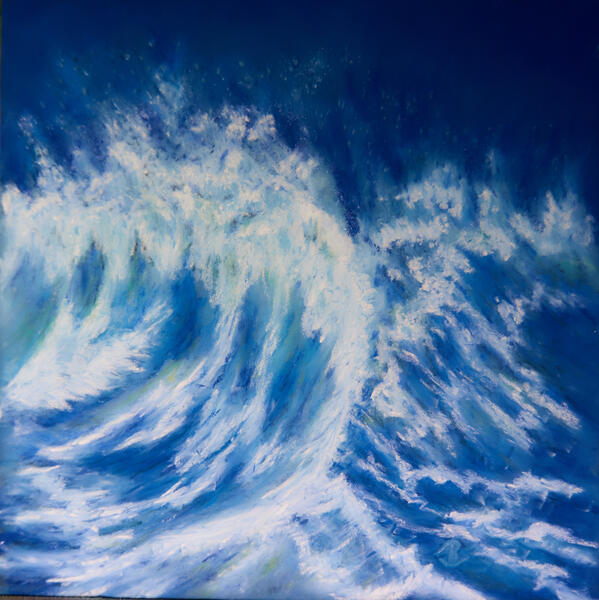 Full Moon Spring Tide17½ x 17½ inches, framed Waves, Cresting, Roaring sea, Colliding, Foaming, Spray, Sea, Crests, pastel, painting, realistic, JBL-Art, Barrie Leigh Shooting for the moon? Or angry at becoming grounded onto the shore? The waves crash together with almost geologic violence.With the moon overhead and the sun lined up to oppose it, tidal waves are pulled to their highest peaks then sucked down to their lowest troughs. Spouts of foam shoot high above the spring-time sea. [Painted in PanPastels, high-pigment powdered paints, and overlaid with traditional soft pastels and pastel pencils. Quality soft pastels on acid-free 200 lb Sennelier pastel card.]
Full Moon Spring Tide17½ x 17½ inches, framed Waves, Cresting, Roaring sea, Colliding, Foaming, Spray, Sea, Crests, pastel, painting, realistic, JBL-Art, Barrie Leigh Shooting for the moon? Or angry at becoming grounded onto the shore? The waves crash together with almost geologic violence.With the moon overhead and the sun lined up to oppose it, tidal waves are pulled to their highest peaks then sucked down to their lowest troughs. Spouts of foam shoot high above the spring-time sea. [Painted in PanPastels, high-pigment powdered paints, and overlaid with traditional soft pastels and pastel pencils. Quality soft pastels on acid-free 200 lb Sennelier pastel card.] -
 Emerald Bay — 16½ x 20½ inches, framedWhat an invitation! A sultry afternoon as the change in tide creates a patchwork of glittering ripples without disturbing the clarity of the pale blue water. Rocky outcroppings sit in a carpet of vivid green seaweed that adds an emerald majesty to the water. High above, a few lonely clouds cast deep blue shadows on the sea. [Painted with hand-made Mungyo soft pastel sticks and Stabilo pastel pencils. The sky and rocky coast were underpainted with PanPastel high-pigment paints. Painted on acid-free Art Spectrum Colourfix 140 lb sanded watercolor paper.]
Emerald Bay — 16½ x 20½ inches, framedWhat an invitation! A sultry afternoon as the change in tide creates a patchwork of glittering ripples without disturbing the clarity of the pale blue water. Rocky outcroppings sit in a carpet of vivid green seaweed that adds an emerald majesty to the water. High above, a few lonely clouds cast deep blue shadows on the sea. [Painted with hand-made Mungyo soft pastel sticks and Stabilo pastel pencils. The sky and rocky coast were underpainted with PanPastel high-pigment paints. Painted on acid-free Art Spectrum Colourfix 140 lb sanded watercolor paper.] -
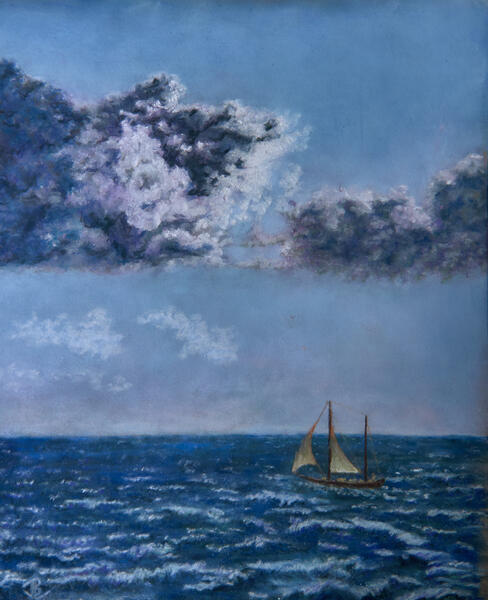 Those in Peril on the Sea18½ x 22½ inches, framed The forceful wind sends waves scudding as it fills the sails of the ketch, rigged for bad weather. The ominous great cloud ahead may be a tribulation for the skipper as the ketch scuds for home and safety. [Sky and sea underpainted in PanPastels, and overlaid with hand-made Mungyo and Sennelier soft pastel sticks. Roiling clouds and cresting waves added with soft Bruynzeel pastel pencils. Painted on acid-free 200lb Sennelier pastel card.]
Those in Peril on the Sea18½ x 22½ inches, framed The forceful wind sends waves scudding as it fills the sails of the ketch, rigged for bad weather. The ominous great cloud ahead may be a tribulation for the skipper as the ketch scuds for home and safety. [Sky and sea underpainted in PanPastels, and overlaid with hand-made Mungyo and Sennelier soft pastel sticks. Roiling clouds and cresting waves added with soft Bruynzeel pastel pencils. Painted on acid-free 200lb Sennelier pastel card.] -
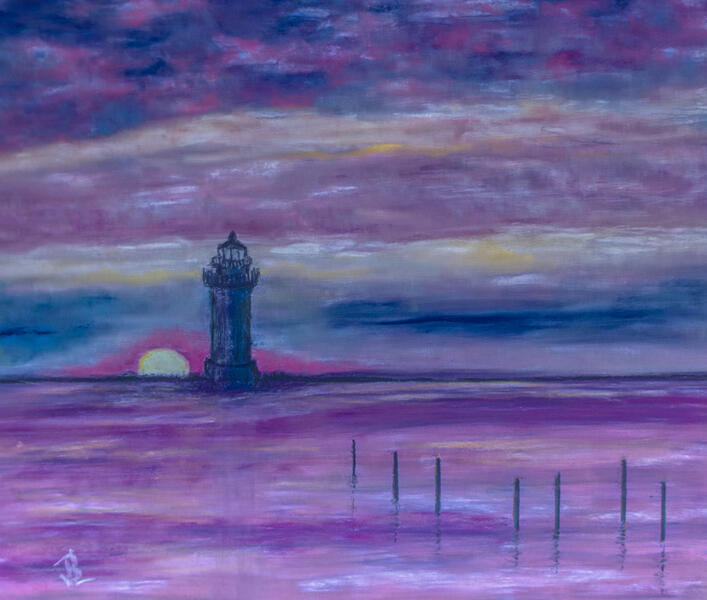 Breakwater Sunset17¾ x 13¾ inches, framed The sunset weaves the clouds and sea into a fabric of streaming layers. But are the clouds glowering or comforting? The placid sea reflects the answer. Multiple layers of clouds shape an amazing sunset from the bay-side beach of Cape Henlopen State Park. A perfect view out to the breakwater lighthouse near Lewes, DE in the Delaware Bay. [Painted with PanPastels and Bruynzeel pastel pencils. Painted on black acid-free Sennelier 200 lb sanded paper.]
Breakwater Sunset17¾ x 13¾ inches, framed The sunset weaves the clouds and sea into a fabric of streaming layers. But are the clouds glowering or comforting? The placid sea reflects the answer. Multiple layers of clouds shape an amazing sunset from the bay-side beach of Cape Henlopen State Park. A perfect view out to the breakwater lighthouse near Lewes, DE in the Delaware Bay. [Painted with PanPastels and Bruynzeel pastel pencils. Painted on black acid-free Sennelier 200 lb sanded paper.]
Mountain Mysteries―A Breath From Our Past
Mountains and mountain ranges create a panorama that is both dramatic and subtly changing from top to bottom and side to side. As we see these scenes through younger eyes, or remember the eyes of our childhood, it's the impressions and memories we recall. My mountain scenes depict colored and scaled expressions of our world. How would the smokies smoke at night-time? When is the early morning sun surrounded by the dark?
Over time, my landscapes have evolved to regain the freshness I saw earlier in life. I start my landscapes using a greyscale reference image. I study the real scene, and reset my view, painting from a black and white version.
Each underpainting’s colors come from the message and the feel of the scene. With later layers of paint and other forms of pastel, I re-introduce the local colors by introducing the original scene’s colorations.
Over time, my landscapes have evolved to regain the freshness I saw earlier in life. I start my landscapes using a greyscale reference image. I study the real scene, and reset my view, painting from a black and white version.
Each underpainting’s colors come from the message and the feel of the scene. With later layers of paint and other forms of pastel, I re-introduce the local colors by introducing the original scene’s colorations.
-
 Mountain Night Vision18½ x 22½ inches, framed Following a sudden sunset, colors may reverse in the sharp light of the moon. The flowing mountain ridges still hold on to the remnants of the day’s mountain mists. .] [Underpainted entirely in PanPastels, high-pigment powdered paints, and overlaid with traditional soft pastels and pastel pencils. Quality soft pastels on acid-free 200lb Sennelier pastel card
Mountain Night Vision18½ x 22½ inches, framed Following a sudden sunset, colors may reverse in the sharp light of the moon. The flowing mountain ridges still hold on to the remnants of the day’s mountain mists. .] [Underpainted entirely in PanPastels, high-pigment powdered paints, and overlaid with traditional soft pastels and pastel pencils. Quality soft pastels on acid-free 200lb Sennelier pastel card -
 Rippling Dream22½ x 18½ inches, framed The light early day breeze across Dream Lake covers its surface in ripples. The pale light of the rising sun gently calls out the varying pastel hues in the ranks of pines covering the mountain sides. [Underpainted with multiple layers of PanPastels, set with alcohol. Overpainted with hand-made Mungyo soft pastels and pastel pencils. Painted on acid-free Sennelier La Carte 200 lb sanded paper.]
Rippling Dream22½ x 18½ inches, framed The light early day breeze across Dream Lake covers its surface in ripples. The pale light of the rising sun gently calls out the varying pastel hues in the ranks of pines covering the mountain sides. [Underpainted with multiple layers of PanPastels, set with alcohol. Overpainted with hand-made Mungyo soft pastels and pastel pencils. Painted on acid-free Sennelier La Carte 200 lb sanded paper.] -
 Seatallan12 x 15 inches, approx Is it greyscale, or is it color? Is it pastel or is it charcoal? It’s not always easy to tell―at first sight. A common Lake District winter scene, made grey by the overcast sky. Craggy granite mountains from Cumberland, England. This is a view from the low trail. Samuel Taylor Coleridge and William Wordsworth may well have walked this path. In the old days, the Vikings lived and died very close to here. They must have thought this a very special view. [Artist quality soft pastels on acid-free 400 grade UArt sanded paper.]
Seatallan12 x 15 inches, approx Is it greyscale, or is it color? Is it pastel or is it charcoal? It’s not always easy to tell―at first sight. A common Lake District winter scene, made grey by the overcast sky. Craggy granite mountains from Cumberland, England. This is a view from the low trail. Samuel Taylor Coleridge and William Wordsworth may well have walked this path. In the old days, the Vikings lived and died very close to here. They must have thought this a very special view. [Artist quality soft pastels on acid-free 400 grade UArt sanded paper.] -
 Alaska’s Kenai Gateway15½ x 18½ inches, framed We all decorate our home’s front door to make the right impression for our house. Look at Alaska’s front door, from the water. Not a bad way to enter a sub-continent. It’s exciting that it’s just one part of our United States. This scene, from June, 2015, looks across Resurrection Bay to the mountain tips in Kenai Gateway County above Spring Creek, Alaska. [The 3D effects on the mountains were created by building up thick layers of soft pastels with an impasto technique. Artist quality Sennelier, Rembrandt and Mungyo soft pastels on acid-free 200 lb. Sennelier pastel card.]
Alaska’s Kenai Gateway15½ x 18½ inches, framed We all decorate our home’s front door to make the right impression for our house. Look at Alaska’s front door, from the water. Not a bad way to enter a sub-continent. It’s exciting that it’s just one part of our United States. This scene, from June, 2015, looks across Resurrection Bay to the mountain tips in Kenai Gateway County above Spring Creek, Alaska. [The 3D effects on the mountains were created by building up thick layers of soft pastels with an impasto technique. Artist quality Sennelier, Rembrandt and Mungyo soft pastels on acid-free 200 lb. Sennelier pastel card.]
Wings & Plumage―3-in-1 Painting
In this portfolio, most paintings were created by painting three often complete layers one on top of another. Few of these pieces were painted simply with one type of pastel, such as “just” PanPastels. As I experimented with different forms of pastel paints, I realized that the greatest strength of pastels comes when you blend together their different forms. Compared to other mediums of paint, pastels provide many distinct forms you can use: powder, paint stick, pencil. Each can carry and convey different effects for your scene.
As the birds around us become bigger and more brightly feathered, their plumage seems to take on a rippling life of its own. The structure of the feathers and the deep shadows between so many of the layers is a challenge for any painting medium. To capture the delicacy of the plumage, I begin with a full painting using PanPastels to color and shape the main elements. I use soft traditional pastel sticks to apply an overcoat of deep pigment that follows the direction of the feathering. The final shaping of the feathers involves pastel pencils to establish the edges of key groups of feathers, and to blur and darken the shadowed areas.
As the birds around us become bigger and more brightly feathered, their plumage seems to take on a rippling life of its own. The structure of the feathers and the deep shadows between so many of the layers is a challenge for any painting medium. To capture the delicacy of the plumage, I begin with a full painting using PanPastels to color and shape the main elements. I use soft traditional pastel sticks to apply an overcoat of deep pigment that follows the direction of the feathering. The final shaping of the feathers involves pastel pencils to establish the edges of key groups of feathers, and to blur and darken the shadowed areas.
-
 Egret and Fish16 x 13 inches, framed In a sheltered cove, a handsome fish tussles in the great egret’s beak. The background foliage merges into a jungle around the inlet. [Underpainted with PanPastels, set with an alcohol wash. Over-painted with hand-made soft pastel sticks and Bruynzeel pastel pencils. Painted on acid-free UART 400-grain sanded paper.]
Egret and Fish16 x 13 inches, framed In a sheltered cove, a handsome fish tussles in the great egret’s beak. The background foliage merges into a jungle around the inlet. [Underpainted with PanPastels, set with an alcohol wash. Over-painted with hand-made soft pastel sticks and Bruynzeel pastel pencils. Painted on acid-free UART 400-grain sanded paper.] -
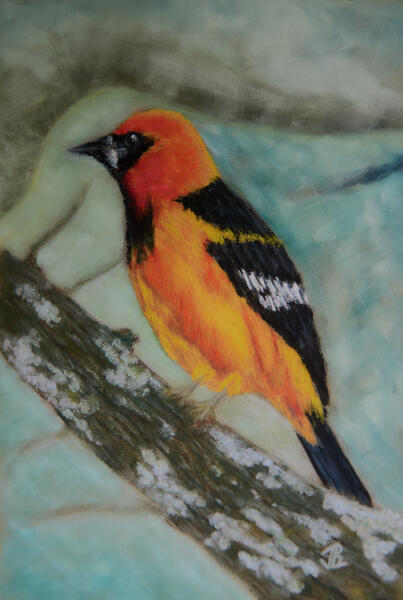 Proud Oriole20½ x 16½ inches, framed A hooded oriole proudly shows the colors of Lord Baltimore’s coat of arms. This member of the oriole family loves the lowlands of the hot and steamy areas across the southern USA. [Painted in PanPastels, with traditional pastels reinforcing the oriole and tree branch. The algae growing vigorously on the branch was added with Sennelier pastels. Painted on acid-free Sennelier 200lb pastel card.]
Proud Oriole20½ x 16½ inches, framed A hooded oriole proudly shows the colors of Lord Baltimore’s coat of arms. This member of the oriole family loves the lowlands of the hot and steamy areas across the southern USA. [Painted in PanPastels, with traditional pastels reinforcing the oriole and tree branch. The algae growing vigorously on the branch was added with Sennelier pastels. Painted on acid-free Sennelier 200lb pastel card.] -
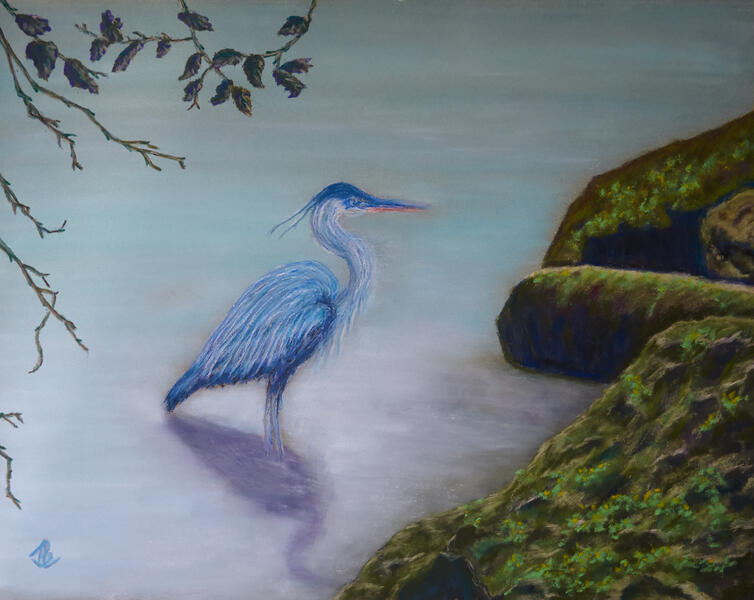 Twilight Shallows19½ x 23½ inches, framed Through a small rocky inlet sheltered from the river in Susquehanna State Park, the Great Blue heron wades the shallows, casting a hazy shadow that fades along with the daylight. The day’s end draws out the subtle coloration of the rocks and their spreading lichen. In the muddy nearby water, it’s rocky reflections we see rather than the deep shadows created earlier that day. [The smooth waters were painted with PanPastels. Soft pastels added depth to the tops of the rocks, and shaped the lichen. CarbOthello pastel pencils overlay the detail and feathering for the heron.]
Twilight Shallows19½ x 23½ inches, framed Through a small rocky inlet sheltered from the river in Susquehanna State Park, the Great Blue heron wades the shallows, casting a hazy shadow that fades along with the daylight. The day’s end draws out the subtle coloration of the rocks and their spreading lichen. In the muddy nearby water, it’s rocky reflections we see rather than the deep shadows created earlier that day. [The smooth waters were painted with PanPastels. Soft pastels added depth to the tops of the rocks, and shaped the lichen. CarbOthello pastel pencils overlay the detail and feathering for the heron.] -
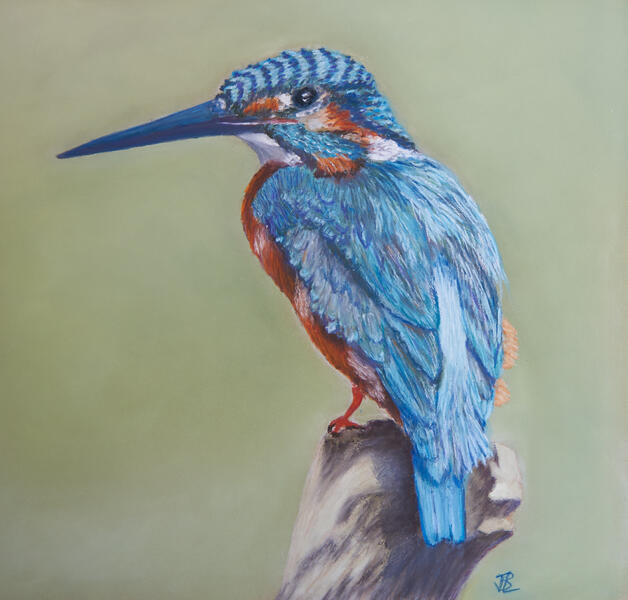 Colonel Fischer19½ x 23½ inches, framed The European kingfisher waits patiently and alertly. His spectacular colors make this bird a childhood favorite. As you look at the bird, his body and wings seem to jump out of the painting towards you. I added this robustness to him not by giving him more feathers, but by deepening those shadows you see between the layers of feathers on his wings. It’s the rippling shadows that show the shape of his sumptuous plumage. This looks like a really well fed bird. [Soft pastels on acid free 200lb. Sennelier pastel card. Background and underpainting with PanPastels.]
Colonel Fischer19½ x 23½ inches, framed The European kingfisher waits patiently and alertly. His spectacular colors make this bird a childhood favorite. As you look at the bird, his body and wings seem to jump out of the painting towards you. I added this robustness to him not by giving him more feathers, but by deepening those shadows you see between the layers of feathers on his wings. It’s the rippling shadows that show the shape of his sumptuous plumage. This looks like a really well fed bird. [Soft pastels on acid free 200lb. Sennelier pastel card. Background and underpainting with PanPastels.] -
 Swan in Green19½ x 23½ inches, framed Water surges before the gentle swimming swan in its search for food. The direction of lighting is very unusual, as most swans are painted facing the light. In this painting, the swan is almost running from the light. Another challenge in the painting is the water ripple in front of the swan’s breast. Notice how the heavy bird actually pushes the water downwards, and the ripple tucks underneath the swan. [Underpainted in PanPastels. Traditional pastels reinforce textures. Sharp edges and blurring added using pastel pencils. Soft pastels on acid-free 200 lb. Sennelier pastel card.]
Swan in Green19½ x 23½ inches, framed Water surges before the gentle swimming swan in its search for food. The direction of lighting is very unusual, as most swans are painted facing the light. In this painting, the swan is almost running from the light. Another challenge in the painting is the water ripple in front of the swan’s breast. Notice how the heavy bird actually pushes the water downwards, and the ripple tucks underneath the swan. [Underpainted in PanPastels. Traditional pastels reinforce textures. Sharp edges and blurring added using pastel pencils. Soft pastels on acid-free 200 lb. Sennelier pastel card.]
Breath Light & Life Into the Still―Shade Edges Our Path
This project is alcohol induced―denatured alcohol, not the kind for drinking. Similarly to the carefully planned multi-layering of watercolors, these pastels were underpainted and overpainted in multiple layers, by setting each layer with alcohol. The soft pastels I apply on top do not blend with the background. This produces an impasto effect of sharp outlines and stark separation of still life elements from their surroundings.
Still lifes provide a canvas to expand our use of high-energy colors, and create eye-catching interest. I bring impressionism into the modern day with: splashes of color to drag your attention, planned pathways of light to curve the direction of your attention through other elements of the scene, and sometimes, pools of deep shade to provide mysteries to unravel.
Still lifes provide a canvas to expand our use of high-energy colors, and create eye-catching interest. I bring impressionism into the modern day with: splashes of color to drag your attention, planned pathways of light to curve the direction of your attention through other elements of the scene, and sometimes, pools of deep shade to provide mysteries to unravel.
-
 Glass of Cherries18½ x 22½ inches, framed The deep red cherries are perfect for eating. Some already fall off their stems. A nearby window and sharp sunlight makes every angle glint in the tulip-shaped glass bowl, casting vivid shadows across the table. [Background and table painted in PanPastels, high-pigment powdered paints. Overpainted with traditional hand-rolled soft pastel sticks and soft pastel pencils from the Netherlands. Painted on black acid-free Sennelier 200lb La Carte sanded paper.]
Glass of Cherries18½ x 22½ inches, framed The deep red cherries are perfect for eating. Some already fall off their stems. A nearby window and sharp sunlight makes every angle glint in the tulip-shaped glass bowl, casting vivid shadows across the table. [Background and table painted in PanPastels, high-pigment powdered paints. Overpainted with traditional hand-rolled soft pastel sticks and soft pastel pencils from the Netherlands. Painted on black acid-free Sennelier 200lb La Carte sanded paper.] -
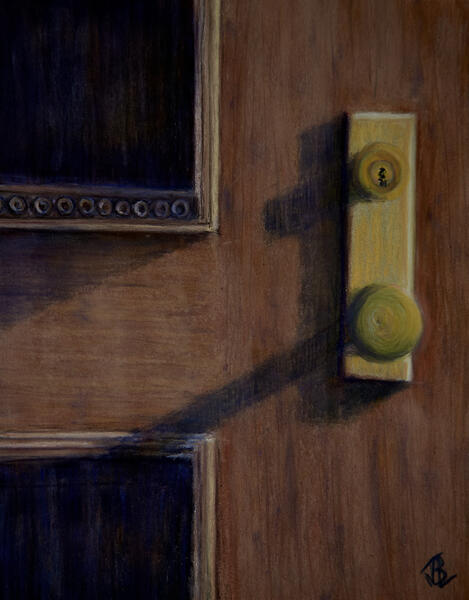 Shadowy Door15½ x 19½ inches, framed The setting sun caught this old door just slightly ajar. The spreading shadows of the day’s end ripple over the textures of the heavily repainted wood. In the pale sunlight, the old brass plate and handle glow as though moonlight is already here. [Underpainted with multiple layers of PanPastels, set with alcohol. Over-painted with hand-made Mungyo soft pastels and pastel pencils. Painted on acid-free Sennelier beige 200 lb sanded paper.]
Shadowy Door15½ x 19½ inches, framed The setting sun caught this old door just slightly ajar. The spreading shadows of the day’s end ripple over the textures of the heavily repainted wood. In the pale sunlight, the old brass plate and handle glow as though moonlight is already here. [Underpainted with multiple layers of PanPastels, set with alcohol. Over-painted with hand-made Mungyo soft pastels and pastel pencils. Painted on acid-free Sennelier beige 200 lb sanded paper.] -
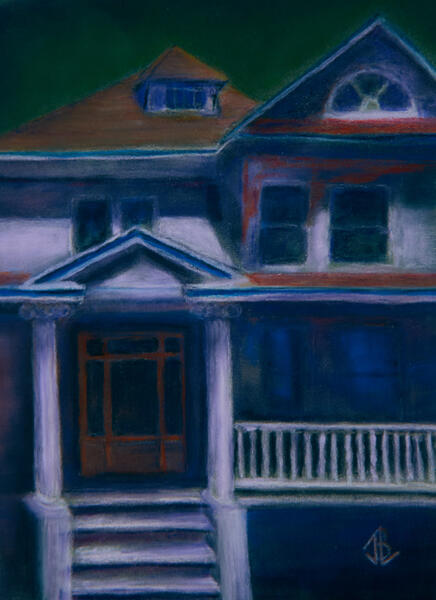 Colonial Home14 x 18 inches, framed This striking old American home glows in sunlight. The depth and layering of its architectural elements stand out—pulled towards us by the light, and sometimes pushed away into shadowy depths. [Underpainted with multiple layers of PanPastels, set with an alcohol wash. Over-painted with hand-made Mungyo soft pastel sticks and Stabilo pastel pencils. Painted on acid-free Sennelier pale green 200 lb sanded paper.]
Colonial Home14 x 18 inches, framed This striking old American home glows in sunlight. The depth and layering of its architectural elements stand out—pulled towards us by the light, and sometimes pushed away into shadowy depths. [Underpainted with multiple layers of PanPastels, set with an alcohol wash. Over-painted with hand-made Mungyo soft pastel sticks and Stabilo pastel pencils. Painted on acid-free Sennelier pale green 200 lb sanded paper.] -
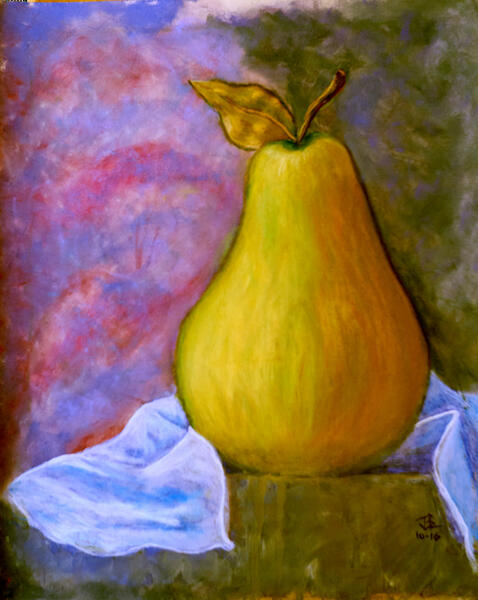 Golden Pear24 x 20 inches, framed The rich golds of the pear stand out from the swirling hot colored wall behind it. The solid-looking shelf on which the pear sits so squarely, seems to flow forwards. To me, the pear is sitting between the swirling earth it came from and the ripening sky on its left. The background textures were all created with free-flowing alcohol solutions of pastel paints. The pleated sheet was painted next. Finally, the pear was placed in center-stage. [Artist quality soft pastels from Sennelier, Rembrandt and Mungyo on acid-free 400 grade UArt sanded paper.]
Golden Pear24 x 20 inches, framed The rich golds of the pear stand out from the swirling hot colored wall behind it. The solid-looking shelf on which the pear sits so squarely, seems to flow forwards. To me, the pear is sitting between the swirling earth it came from and the ripening sky on its left. The background textures were all created with free-flowing alcohol solutions of pastel paints. The pleated sheet was painted next. Finally, the pear was placed in center-stage. [Artist quality soft pastels from Sennelier, Rembrandt and Mungyo on acid-free 400 grade UArt sanded paper.]
Those Blooming Flowers―The World of Shadows
In a lovely painting of a single bloom with its touchable soft-edged curving petals―where did those gracious shapes come from? How do they rise off the painting towards you? In my case, these flowers rise from their ashes. The feeling you get from looking at a flower often comes from the color of the flower’s shade, as much as from the natural local color of the flower itself. It’s like starting at the back of a flower, and then working towards the light.
I paint flowers by first creating a painting of only shadows. This painting uses the shadow colors. The color left over to shine through a petal after the local color you see has been reflected out of it. The shadowy areas blend and bleed through each petal to shape them. Darker shadows separating deeper layers of petals.
What you may notice first, is often added only last. Crusting each petal, the brightest and lightest highlights are added at the end, and blended to show the curving and rippling petal. Pastel pencils add the clear curving edges of the petals.
My flowers are painted backwards, from back to front―and ending on the brightest tones.
I paint flowers by first creating a painting of only shadows. This painting uses the shadow colors. The color left over to shine through a petal after the local color you see has been reflected out of it. The shadowy areas blend and bleed through each petal to shape them. Darker shadows separating deeper layers of petals.
What you may notice first, is often added only last. Crusting each petal, the brightest and lightest highlights are added at the end, and blended to show the curving and rippling petal. Pastel pencils add the clear curving edges of the petals.
My flowers are painted backwards, from back to front―and ending on the brightest tones.
The Tale’s Tail―The Invitation
As the Bard once said: “Once more unto the breach, dear friends, once more.”
And what was a “breach” anyway? In fact, it was a hole in your wall. A risky thing to leave uncovered in the days of kings and castles.
But, do you have any breaches around your home?
The blank areas on your walls, where a painting would be just the thing to:
enliven your day, cheer up your room, make you reminisce, give you pause for thought...or a thousand reasons more.
Did you discover some pieces on your journey through this portfolio that you’d like to see more often?
In fact, you could see them whenever you wanted to. We can arrange for that.
You’ll also find my full portfolio has even more paintings than those you saw here.
Friends tell me my paintings are much more impressive in person than these photos over the internet, and they may be right.
The best thing to do is to contact me.
We can work together on what you’re looking for, or even meet at the Artists’ Emporium in Havre de Grace,
where a number of my paintings hang.
And what was a “breach” anyway? In fact, it was a hole in your wall. A risky thing to leave uncovered in the days of kings and castles.
But, do you have any breaches around your home?
The blank areas on your walls, where a painting would be just the thing to:
enliven your day, cheer up your room, make you reminisce, give you pause for thought...or a thousand reasons more.
Did you discover some pieces on your journey through this portfolio that you’d like to see more often?
In fact, you could see them whenever you wanted to. We can arrange for that.
You’ll also find my full portfolio has even more paintings than those you saw here.
Friends tell me my paintings are much more impressive in person than these photos over the internet, and they may be right.
The best thing to do is to contact me.
We can work together on what you’re looking for, or even meet at the Artists’ Emporium in Havre de Grace,
where a number of my paintings hang.
